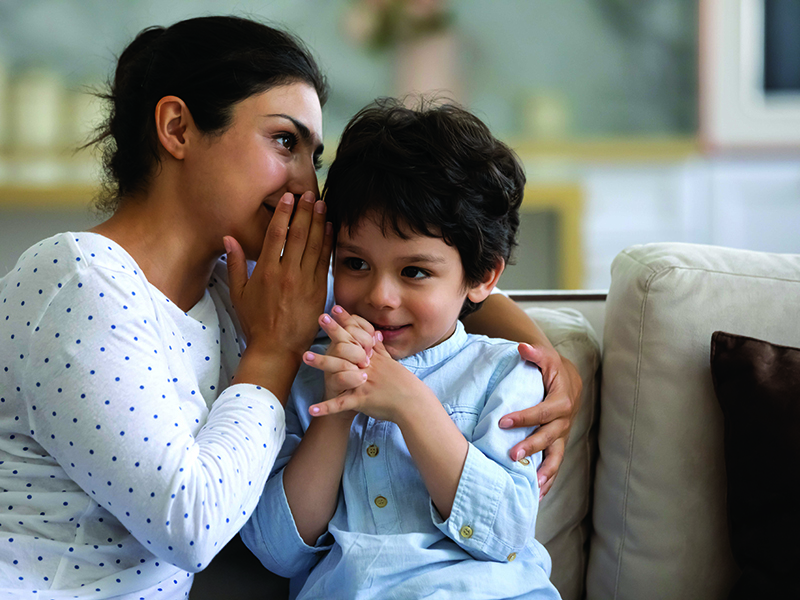
Jane Herbert
A development psychologist explains ‘parentese’
You might have seen those heartwarming and often funny viral videos where parents or carers engage in long “talks” with young infants about this and that – usually just fun chit chat of no great consequence.
They’re often very sweet, and it’s lovely to see the babies’ faces lighting up at the sound of their mother or carer’s voice, or seeming to talk back. In one, the baby appears to reply in an accent strikingly similar to their carer’s.
So, what’s going on when we chat like this to babies? And is it better to chat to them in the tone and pace we’d use when talking to other adults, or is it OK to talk in a slower, higher pitched, sing-song voice?
Here’s what the research shows thus far.
 Talking to your baby matters
Talking to your baby matters
When you speak with your baby, they are exposed to a rich tapestry of sounds and movements. Can infants make sense of all this input?
Well, by the time they’re born babies are already highly accustomed to their mother’s voice as well as other language sounds they’ve heard while in utero.
Understand how AI is changing society
In fact, research shows newborns prefer listening to the language they heard in utero rather than an unfamiliar language.
They also prefer to hear the story their mother read aloud regularly in the final weeks of pregnancy, compared to a different story — regardless of who is reading it.
So, although newborns are yet to understand the meaning of words, they are already tuned in to the importance of language.
Given the vast exposure that most young babies have with their parent’s voice, passively listening to mum or dad talking is likely to be comforting.
Time spent together in close physical contact with a highly familiar person producing familiar sounds creates a safe, secure space rich in learning opportunities.
Babies can learn a lot about conversational style from just listening to and watching how their parent communicates.
In fact, babies mimic their parents’ voice and gestures, which helps build their vocabulary over time. The social context influences language skills.
What if I run out of things to say?
If you’re not a fan of monologuing with your baby, don’t worry. They’re not missing out.
In fact, constant exposure to long monologues by a parent is unlikely to provide the baby with a particularly supportive language environment for developing understanding or production of words.
Adult language is very complex. It takes a lot of experience with language before a string of sounds like “Yourdadlikeschocolatemoltenlavacake” can be interpreted as individual words linked to people, objects, or concepts.
One of the most effective ways to support early word recognition and promote attention to the structure of language is for adults to use simplified ways of speaking to infants.
“Parentese” is characterised by the use of higher pitch sounds, elongated vowels, and a slower articulation. Real words are presented in a sing-song, happy voice.
Parentese draws the baby’s attention to words, and highlights how information in speech chunks together. Babies have been found to prefer to listen to this style of speaking compared to standard speech.
 Speaking ‘parentese’
Speaking ‘parentese’
Parentese is not the same as “baby talk”. Baby talk involves the use of nonsense words, and the modelling of incorrect speech sounds and grammar. A baby is not being supported to learn the word “water” if they are repeatedly presented with a nonsense label like “waa waa” for their drink.
One US study found that when parents were trained to use parentese with their infants of six and ten months, the infants showed increase in babbling and said more words at 14 months, compared to infants of parents who did not receive this training.
Other research has shown consistent use of parentese in early years can help build the complexity of children’s language skills up to five years of age.
Learning to talk is not simply the product of hearing lots of words. In the first weeks of life, infants are already beginning to produce coos and murmurs that parents and outside observers judge to be intentional vocalisations.
Try responding to these sounds by imitating them and then interpreting what your baby might be trying to say. This enables them to take a turn as a social partner in the conservation.
When even very young babies take turns in conversations with an adult, the quality of their vocalisations improves.
At youngest ages, time spent talking together in face-to-face interactions best supports language development.
With age, infants become increasingly interested in the objects in their environment.
So, what should parents do?
An effective way to boost language learning from about nine months of age is to notice what’s captured your baby’s attention and talk about that.
Try labelling and describing what your baby is looking at, playing with, pointing at, or babbling towards.
Research by colleagues and I found encouraging parents to engage in 15 minutes of this type of talk per day with their 11-month-olds for a month is effective in promoting vocabulary growth at 15 and 18 months.
Overall, a rich language environment is created by engaging with your baby in a wide range of activities — via games, songs, and reading aloud — not just having focused conversations.
(Jane Herbert is Associate Professor in Developmental Psychology, University of Wollongong, Australia)
(This article is republished from The Conversation under a Creative Commons license)























